High-yielding cabbage variety Moskovskaya Pozdnaya
Brought out in the middle of the 20th century, the Moscow late variety of white cabbage has not yet lost its popularity. This is explained by its numerous positive characteristics, among which the density, large size and sweet taste of heads of cabbage, frost resistance and unpretentiousness are especially noteworthy. In this article we will talk about the advantages and disadvantages of Moscow late, as well as the variety’s requirements for planting and care.
Description of the variety
Moscow late is a late-ripening variety of white cabbage of domestic selection.
Forms large, dense, flat-rounded heads of cabbage that are suitable for fresh consumption, as well as pickling, fermentation and preparation of dishes requiring heat treatment.
Origin and development
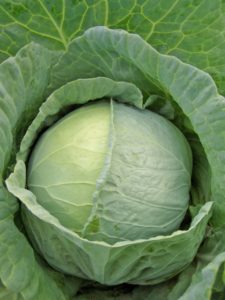
There are 2 similar varieties registered in the State Register of Agricultural Crops of Russia: Moskovskaya Pozdnyaya 15 and Moskovskaya Pozdnyaya 9.
The first was bred by breeders Alekseev and Klapste based on the Pyshkinskaya variety, included in the State Register in 1943 with permission for cultivation in the North-Western, Central, Volga-Vyatka and Far Eastern regions. The second has been under variety testing since 1957, and was included in the State Register in 1968 for the Central and North-Western regions.
Originator: Federal Scientific Center for Vegetable Growing.
Chemical composition and beneficial properties
100 g of vegetable contains:
- dry matter - 6.8-10.1%;
- sugar - 3.5-5.41%;
- ascorbic acid - 22-45 mg.
Cabbage also contains vitamins B5, E, B6, B2, B1, phosphorus, calcium, and chlorine.
Eating white cabbage helps normalize metabolic processes. It is especially useful for people who have been diagnosed with atherosclerosis, gout, and cardio-renal diseases. The vegetable has anti-inflammatory and analgesic properties.
Features of application
Moskovskaya late cabbage heads are suitable for fresh consumption. They are used for fermentation, pickling, frying, stewing, salting, preparing cabbage rolls and first courses.
Ripening time and yield
This is a late-ripening cabbage variety. Heads of Moscow late 15 are ready for harvesting 143-160 days after the appearance of mass shoots, Moscow late 9 - after 125-140 days.
The average yield is 602-885 c/ha, the maximum is 1015 c/ha.
Resistance to disease and cold
The variety is resistant to clubroot, but it can be affected by black leg, downy mildew, mucous bacteriosis, cruciferous flea beetles, slugs, and cabbage flies.
The standing heads of this cabbage variety can withstand air temperatures down to -7°C, but freezing has a negative impact on the keeping quality of the crop.
Appearance and taste
Moscow late is characterized by a spreading leaf rosette, the diameter of which exceeds 1 m. The leaves are oval-shaped, green-gray, wrinkled, covered with a thin waxy coating, and there are coarse veins on the surface of the leaf blades.
The heads of cabbage are dense, flat-rounded, white-yellow in cross section, weigh on average 5 (Moskovskaya late 15) and 8 kg (Moskovskaya late 9). Some specimens, under favorable conditions and proper care, grow up to 15 kg. The outer stalk reaches 0.3 m, the inner one is of medium length.
The cabbage is juicy, has a balanced taste, and is sweet.
Suitable regions
According to the State Register of Russia, Moscow late zoned in the Northwestern, Central, Volga-Vyatka and Far Eastern regions. Due to its unpretentiousness to climatic conditions, the variety is successfully grown in other areas.
Advantages and disadvantages of the Moscow late variety
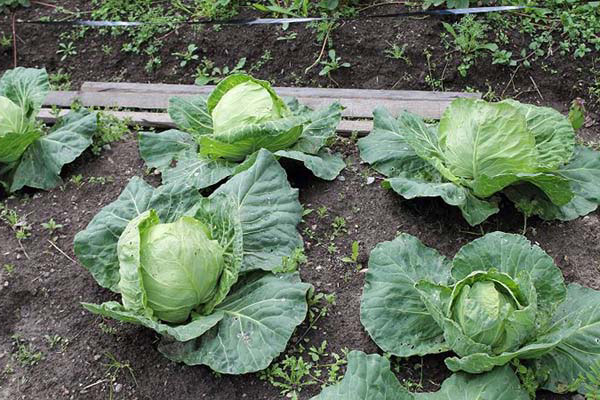
Main advantages:
- high productivity;
- density, juiciness, universal use of heads of cabbage;
- high sugar and vitamin C content;
- uniform ripening of the crop;
- resistance to keeling and cracking;
- good keeping quality and transportability;
- high yield of marketable products;
- frost resistance.
The disadvantages include a high stalk, which may not support the weight of the head of cabbage. Because of this, cabbage is hilled high or supports are used.
Difference from other varieties and hybrids
Comparison of Moscow late with other late-ripening cabbage varieties in the table.
| Variety | Head shape | Head weight, kg | Average yield, c/ha |
| Moscow late | Round-flat | 5-8 | 602-885 |
| Kharkov winter | 3,5-4,2 | 583-832 | |
| Wintering 1474 | 2-3,6 | 450-523 | |
| Aggressor | Round | Up to 5 | 431-650 |
Features of planting and growing
The requirements for planting and growing for Moscow late are the same as for other late-ripening varieties of white cabbage. It is grown by seedlings and without seedlings; The main thing is to properly prepare the planting material and observe the sowing dates.
Preparing to plant seeds and seedlings
Seeds before planting, they are calibrated, immersed in hot (+50°C) water for half an hour and in cold water for 2-3 minutes for disinfection. Then the planting material is put into the refrigerator for a day, after which it is thoroughly dried.
In central Russia, seeds are sown for seedlings in early to mid-April. You can purchase a ready-made substrate or prepare it yourself by mixing turf, compost, humus and coarse sand. The soil mixture is calcined in the oven or spilled with a solution of potassium permanganate for disinfection.
The seeds are buried in moist soil 1 cm every 5-7 cm. The containers are covered with polyethylene and kept at an air temperature of +23°C. With the emergence of seedlings, the temperature is maintained within +15...+18°C during the day and +8...+10°C at night.
When 2-3 true leaves are formed on the sprouts, pick. By the appearance of 5-6 leaves (35-40 days after germination), the readiness of the seedlings for transplanting into the beds is judged.
How to plant without seedlings
Planting material is sown directly on the beds at the end of April. Planting holes are made at a distance of 40 cm from each other, 2-3 seeds are placed in each and they are buried 3 cm. After germination, the plantings are thinned out, leaving 1 strongest sprout.
Reference. Immediately after sowing, the beds are covered with film.
Soil requirements and predecessors
To plant Moscow late, choose a well-lit place with fertile, loose, light, slightly acidic or neutral loamy soil.
Cabbage should not be grown in acidic soil due to the increased risk of clubroot and in areas where cruciferous crops have been grown within the last 3 years.
Dates, scheme and rules of planting
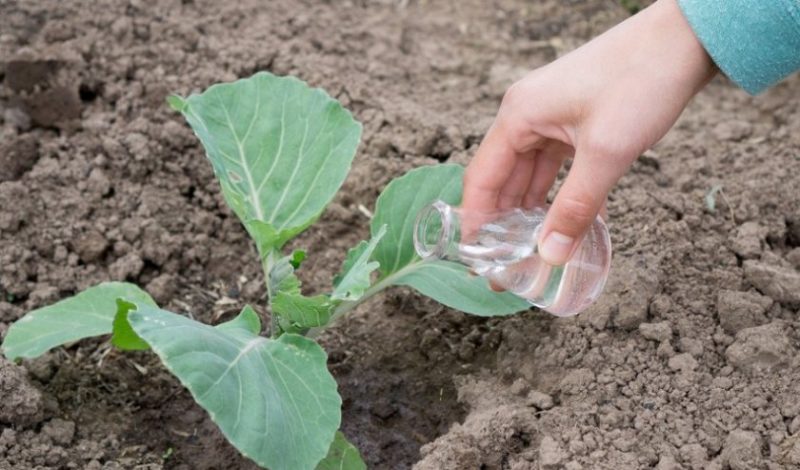
The seedlings are transplanted into beds at the age of 35-40 days. By this time, the plants should reach a length of 20 cm and have 5-6 true leaves.
Planting pattern:
- On the site prepared in the fall, form beds at a distance of 70 cm from each other.
- Make planting holes in them every 50 cm.
- Add 40 g of urea and nitrophoska to each well.
- Place in the center of the hole seedling.
- Fill the voids with soil, compact it slightly, and water the plantings.
Nuances of care
Moscow Late is an unpretentious variety that does not have any specific care requirements. It is important to comply with standard agrotechnical requirements: timely feed and water the plants, treat them from diseases And pests, regularly loosen and weed the soil.
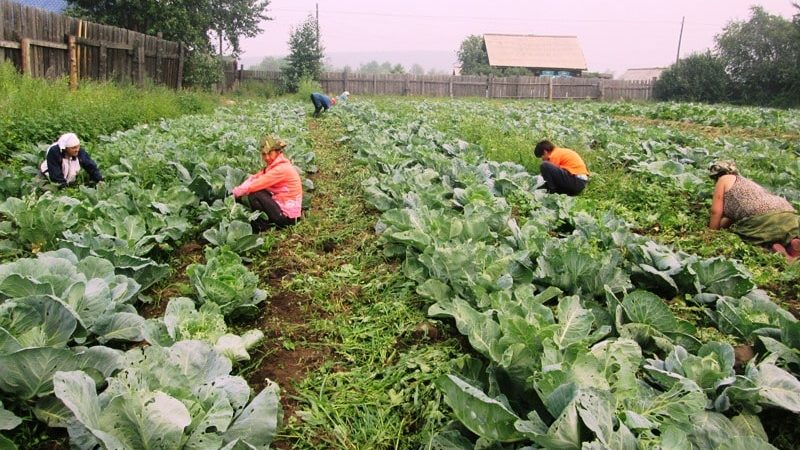
Watering mode
The plantings are watered weekly, pouring 3 liters of settled water at room temperature under the root of each bush. Drip watering can lead to cracking of the heads of cabbage.
Loosening and hilling
After each watering or rain, the soil around the plants is loosened to improve its moisture permeability and aeration. At the same time, weeds are removed, the presence of which can contribute to the occurrence of fungal diseases. To reduce the frequency of loosening, the soil is mulched with hay, straw or rotted sawdust.
Cabbage of this variety is hilled up at least 3 times per season: a month after transplanting the seedlings, then several more times, when the forks rise a few centimeters above the ground.
Top dressing
Fertilizers are applied according to the following scheme:
- in autumn - 30-40 g of superphosphate and 5-7 kg of manure or humus per 1 sq. m for digging; if the soil is acidified, add 0.5 kg of dolomite flour;
- in summer (twice with an interval of 10-14 days) - 10-20 g of potassium monophosphate or potassium sulfate and 1 liter of chicken droppings or manure dissolved in water per 1 sq. m.
From the second half of September, fertilizing and watering are stopped.
Measures to increase yield
To get a bountiful harvest of Moscow late, you need to choose the right place to plant cabbage, water and feed the plants in a timely manner, and do not neglect preventive measures against diseases and pest attacks.
Reference. The yield can be increased due to the low planting density - 80x80 cm.
Disease and pest control
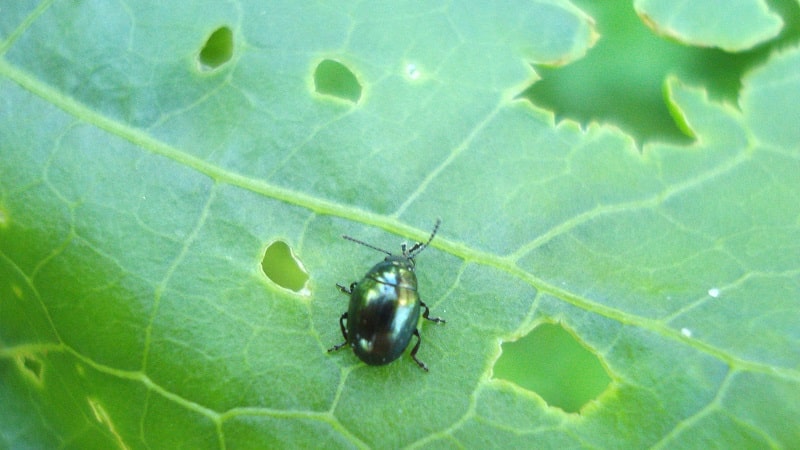
Diseases and pests dangerous to this variety are described in the table.
| Disease/pest | Signs | Treatment/prevention |
| Blackleg | The stems of seedlings and seedlings darken and become watery. | The plantings are treated with biofungicides (“Fitosporin”, “Planriz”, “Binoram”). |
| Downy mildew | Gray powdery coating on the cotyledons and leaves of seedlings, yellow spots on the upper side of the leaves. | |
| Mucous bacteriosis | Wet mucus appears on the surface of the heads of cabbage. | |
| Cruciferous flea beetles | Many very small holes appear in the leaves. | Plants are treated with insecticidal preparations, for example, “Anabasin-sulfate” and “Bitoxibacillin”. |
| Cabbage flies | The larvae infect the roots of plants. | |
| Slugs | Pests gnaw through the heads of cabbage. | The drug "Grom" is used. |
Difficulties in growing
When growing Moscow late, you may encounter the following problems:
- blackening, wateriness of seedling stems - symptoms of black leg, which is caused by high humidity;
- pile up the heads of cabbage in the beds - the long stalk cannot withstand the large size and weight of the heads of cabbage, it is necessary to hill up the plants or use supports.
Harvest and storage
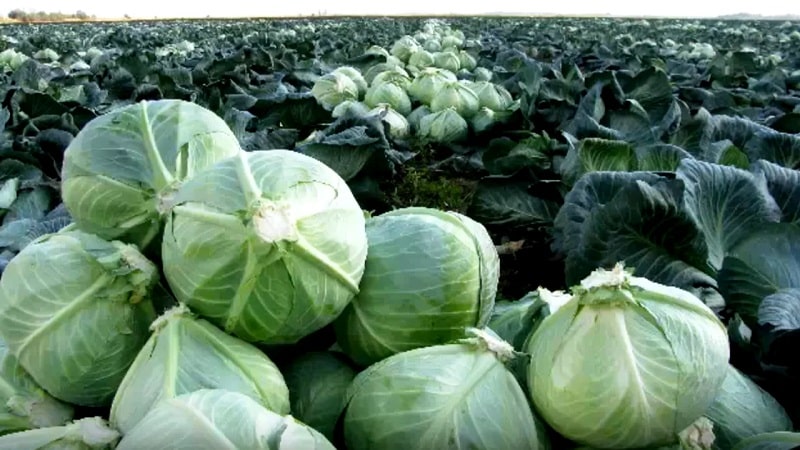
Harvest time depends on the climate of the growing region of Moscow late. On average, the heads of cabbage ripen in mid-October, when they become firm and dense.
The harvest is harvested in cool weather by pulling the heads of cabbage out of the ground and leaving them there for 3-4 days until the outer leaves wither. Then they are removed and the outer stalk is shortened to 2-3 cm.
For storage The strongest heads of cabbage are selected. The rest are set aside for immediate use. Store cabbage on wooden shelves, laid in 1 row or wrapped in cling film. In a dry, cool and dark basement, Moscow late is stored for up to six months.
Tips and reviews from experienced gardeners
Experienced gardeners recommend:
- harvest in cool weather, this will extend the shelf life of the forks;
- do not use drip irrigation - water getting on the heads of cabbage can lead to their cracking, despite the lack of a tendency for the variety to do this.
Vegetable growers speak positively about the variety.
Irina, Bryansk: “My mother and grandmother grew this variety, and now here I am. I see no reason to change it to something else. Moscow Late is an unpretentious cabbage that requires minimal care. The heads of cabbage are large, dense, very tasty, juicy and sweet, and sauerkraut The sight is simply delicious. The harvest is stored for a long time, enough for the whole winter.”
Vasily, Rostov region: “When I planted this variety for the first time, I thought that I would never return to it - all the heads of cabbage fell over, some cracked. In general, the first damn thing is lumpy. A few years later I decided to try again, already knowing that this variety definitely needs to be hilled and make sure that when watering, water does not get on the forks. As a result, I got an excellent harvest of large, dense, tight and very tasty heads of cabbage.”
Conclusion
Moscow late is a late-ripening variety of white cabbage, bred by domestic breeders.It is characterized by high yield, resistance to frost, cracking and clubroot, good keeping quality and dense, juicy, large heads of cabbage. The only disadvantages include the need for hilling or using supports.